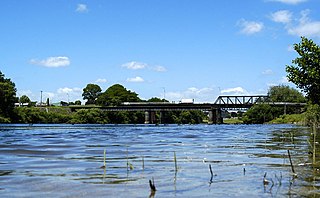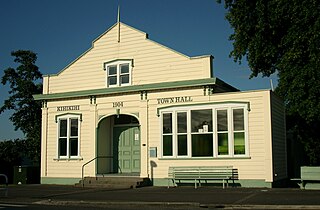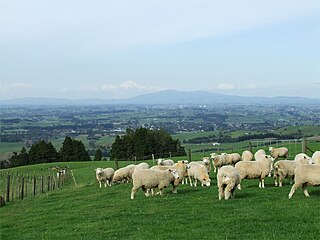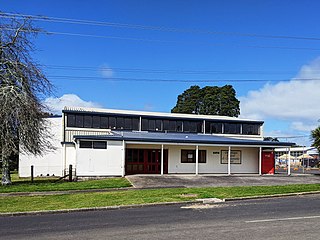
Ngāruawāhia is a town in the Waikato region of the North Island of New Zealand. It is located 20 kilometres (12 mi) north-west of Hamilton at the confluence of the Waikato and Waipa Rivers, adjacent to the Hakarimata Range. Ngāruawāhia is in the Hamilton Urban Area, the fourth largest urban area in New Zealand. The location was once considered as a potential capital of New Zealand.
Te Awamutu is a town in the Waikato region in the North Island of New Zealand. It is the council seat of the Waipa District and serves as a service town for the farming communities which surround it. Te Awamutu is located some 30 kilometres (19 mi) south of Hamilton on State Highway 3, one of the two main routes south from Auckland and Hamilton.
Otorohanga is a north King Country town in the Waikato region in the North Island of New Zealand. It is located 53 kilometres (33 mi) south of Hamilton and 18 kilometres (11 mi) north of Te Kuiti, on the Waipa River. It is a service town for the surrounding dairy-farming district. It is recognised as the "gateway" to the Waitomo Caves and as the "Kiwiana Town" of New Zealand. Until 2007, Otorohanga held a yearly 'Kiwiana Festival.'
Ruakura is a semi-rural suburb of Hamilton City, in the Waikato region of New Zealand. The University of Waikato is nearby.

Kawhia Harbour is one of three large natural inlets in the Tasman Sea coast of the Waikato region of New Zealand's North Island. It is located to the south of Raglan Harbour, Ruapuke and Aotea Harbour, 40 kilometres southwest of Hamilton. Kawhia is part of the Otorohanga District Council and is in the King Country. It has a high-tide area of 68 km2 (26 sq mi) and a low-tide area of 18 km2 (6.9 sq mi).

Kihikihi, a small town located in the Waikato region of the North Island of New Zealand, serves as a satellite community of Te Awamutu, five kilometres to the north, and lies 35 kilometres south of Hamilton. The 2018 New Zealand census recorded a population of 2,808 people The main reason for the large increase since 2013 is the construction of a large number of new dwellings.

Port Waikato is on the south bank of the Waikato River at its outflow into the Tasman Sea, in northern New Zealand. It is currently a village with a population of 516 in the 2018 New Zealand census.

Pirongia is a small town in the Waipa District of the Waikato region of New Zealand's North Island. It is 12 kilometres to the west of Te Awamutu, on the banks of the Waipa River, close to the foot of the 962 metre Mount Pirongia, which lies in Pirongia Forest Park to the west of the town.
Te Kauwhata is a small town in the north of the Waikato region of New Zealand, situated close to the western shore of Lake Waikare, some 40 km north of Hamilton.

Taupiri is a small town of about 450 people on the eastern bank of the Waikato River in the Waikato District of New Zealand. It is overlooked by Taupiri mountain, the sacred burial ground for the Waikato tribes of the Māori people, located just to the north.
Paterangi is a settlement in the Waikato region of New Zealand's North Island. It is located 10 km northwest of Te Awamutu. It is close to the site of one of the most strongly fortified pa built during the New Zealand wars of the late 19th century.

Te Pahu is a rural community in the Waipa District and Waikato region of New Zealand's North Island, located just north of Cambridge across State Highway 1.

Onewhero is a village and rural community in the Waikato District and Waikato region of New Zealand's North Island. The village had a population of about 390 in the 2018 New Zealand census;

Ōhaupō is a rural community in the Waipa District and Waikato region of New Zealand's North Island. It is located on State Highway 3, about halfway between Hamilton and Te Awamutu.
Pokuru is a rural community in the Waipa District and Waikato region of New Zealand's North Island.
Pukeatua is a rural farming community in Waipa District and Waikato region of New Zealand's North Island. It is situated at the south-western foot of the Pukeatua hill, of the Maungatautari mountain range.
Ngāhinapōuri is a rural community in the Waipa District and Waikato region of New Zealand's North Island. It is located on State Highway 39, between Whatawhata and Pirongia.
Hautapu is a township in the Waipa District and Waikato region of New Zealand's North Island, located just north of Cambridge across State Highway 1.
Rukuhia is a rural community in the Waipa District and Waikato region of New Zealand's North Island.
Karapiro or Karāpiro is a settlement and rural area in the Waipa District and Waikato region of New Zealand's North Island. It includes both the artificially created Lake Karapiro and the accompanying Karapiro Power Station. Karapiro is located just off State Highway 1, south-west of Cambridge.









